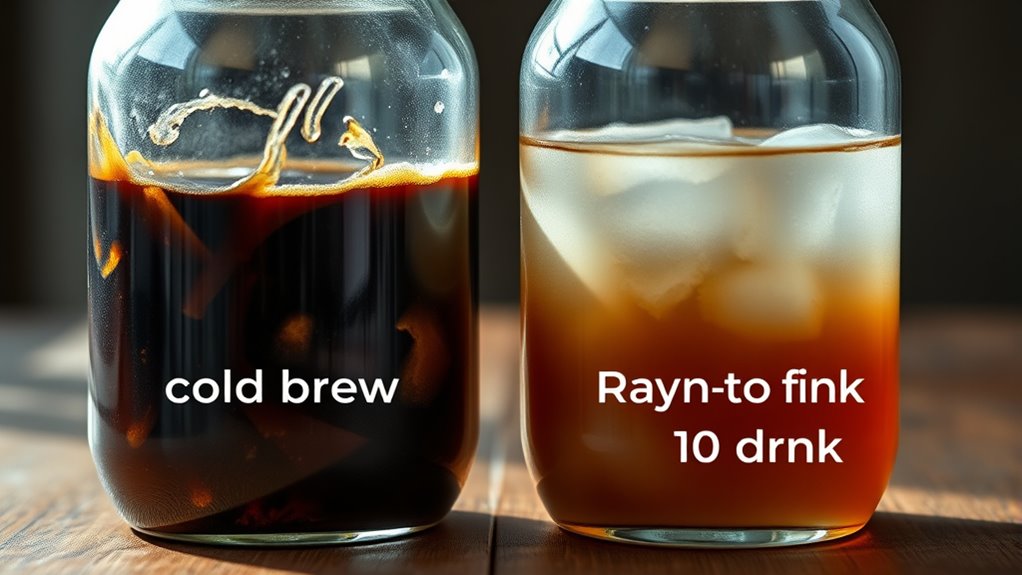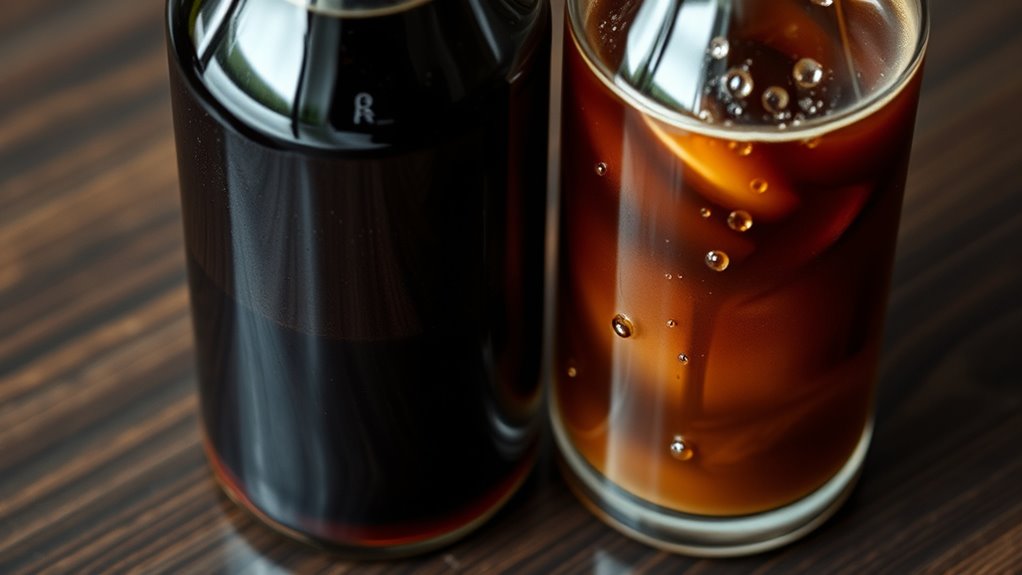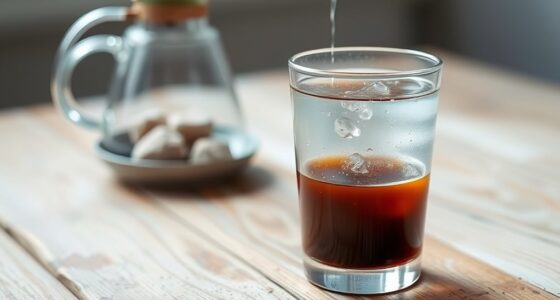When you’re making cold brew, a concentrate uses a higher coffee-to-water ratio, like 1:4, resulting in a stronger, richer brew that you can dilute later. Ready-to-drink recipes, with ratios around 1:8 or 1:10, produce a lighter, milder beverage ready to enjoy without extra mixing. Knowing these ratios helps you customize your flavor and strength. Keep exploring, and you’ll discover how to perfect each method for your ideal cold brew.
Key Takeaways
- Concentrate cold brew uses higher coffee-to-water ratios (e.g., 1:4) for a thick, intense flavor, while ready-to-drink uses lower ratios (e.g., 1:8 or 1:10) for lighter taste.
- Concentrate is brewed with coarser grounds and longer steep times to maximize flavor extraction without over-dilution.
- Ready-to-drink cold brew is often diluted or made with less coffee, resulting in a smoother, more approachable beverage.
- Adjusting the ratio allows customization of flavor strength, with concentrates emphasizing boldness and ready-to-drink favoring clarity.
- The chosen ratio directly impacts brewing technique, flavor profile, and whether the final product is meant to be diluted or enjoyed straight.

Making great cold brew coffee depends largely on getting the right coffee-to-water ratio. This ratio determines not just the strength but also the overall flavor profile of your brew. When exploring cold brew ratios, you’ll find that different brewing techniques require different approaches, and these choices directly impact the taste and texture of your coffee. Whether you’re making a concentrate or a ready-to-drink version, understanding how to adjust your ratios is key to achieving the perfect cup.
Mastering cold brew starts with the perfect coffee-to-water ratio for ideal flavor and strength.
If you’re brewing a concentrate, you typically use a higher coffee-to-water ratio. This means fewer cups of water for a given amount of coffee grounds, resulting in a thicker, more intense brew. Concentrates are versatile because you can dilute them later, customizing strength to your preference. For example, a common ratio for concentrate might be 1:4 (one part coffee to four parts water), which produces a robust, full-bodied flavor. Using this ratio, your brewing techniques focus on extracting maximum flavor without over-diluting. The goal is to preserve the rich, bold flavor profiles that make cold brew distinctive. When you brew a concentrate, pay close attention to steep time and grind size, both of which influence the flavor extraction. A coarser grind and a longer steep time help avoid over-extraction, keeping your concentrate smooth and flavorful. Additionally, considering grind size and steep time can optimize flavor extraction and prevent over-extraction, ensuring a balanced brew.
On the other hand, ready-to-drink cold brew generally has a lower coffee-to-water ratio, making it more diluted and easier to enjoy straight from the bottle. This version often uses ratios like 1:8 or 1:10, which produce a lighter, more approachable flavor profile. Your brewing techniques here focus on extraction that balances strength and clarity, ensuring the flavor isn’t too concentrated or weak. When preparing a ready-to-drink cold brew, you might use less coffee grounds or dilute the concentrate after brewing. This flexibility allows you to tailor the flavor profile to suit your tastes or intended use. For instance, you can add milk or sweeteners without overpowering the delicate coffee notes, which is harder to do with a highly concentrated brew.
Ultimately, understanding cold brew ratios helps you control the flavor profiles you want to achieve. Whether you prefer a strong, rich concentrate or a smooth, ready-to-drink coffee, your choice of ratios influences the brewing techniques you employ. Adjusting these ratios allows you to craft a cold brew that’s perfectly suited to your taste, providing a satisfying and customizable coffee experience every time.
Frequently Asked Questions
How Do I Adjust Ratios for Different Flavor Preferences?
To adjust ratios for different flavor preferences, start by experimenting with dilution preferences. If you want a stronger coffee flavor, use less water or milk; for a milder taste, add more. Flavor adjustments are easy—try adding a splash of milk, sweetener, or flavorings like vanilla or cinnamon. Keep track of your ratios as you go, so you can customize each cup to match your ideal flavor profile.
What Equipment Is Best for Making Cold Brew Concentrate?
Imagine you’re a modern-day alchemist, but for cold brew. The best equipment for making concentrate includes a large glass or stainless steel container, a fine coffee filtration system like a fine mesh or cheesecloth, and a reliable grinder. Keep brewing temperatures between 35-40°F to prevent over-extraction. This setup guarantees you get a smooth, rich concentrate every time, perfect for customizing your drinks to your flavor preferences.
How Long Can Cold Brew Concentrate Be Stored?
You can store cold brew concentrate for up to two weeks in the fridge, but be mindful of spoilage risk. To keep it fresh, use a clean, airtight container and always smell or taste a small amount before using. After two weeks, the concentrate may develop off-flavors or spoil, so it’s best to consume it within that time frame to enjoy peak freshness and safety.
Can I Use Flavored Beans With Cold Brew Ratios?
Using flavored beans in your cold brew is like adding a splash of color to a black-and-white photo. Flavored bean considerations include their added oils and aromas, which can affect extraction and flavor clarity. Opt for medium to dark roasts, as they tend to hold flavors better during cold brewing. Just keep in mind that intense flavors might overshadow the natural cold brew profile, so experiment to find your perfect balance.
Is There a Health Difference Between Concentrate and Ready-To-Drink?
You won’t notice significant health benefits difference between concentrate and ready-to-drink cold brew, but watch the sugar content. Concentrates often have less added sugar, making them a healthier choice if you’re mindful of sugar intake. Ready-to-drink options might contain more sugar for flavor, which could impact your health if consumed in excess. Always check labels to compare sugar levels and choose the option that best supports your health goals.
Conclusion
So there you have it—mastering cold brew ratios is practically a superpower. Whether you prefer a potent concentrate or a sip-ready drink, just remember: it’s all about your taste buds, not some mystical formula. Play around, find what makes you happy, and don’t stress the math. After all, coffee is supposed to be your daily joy, not a chemical experiment. Cheers to brewing exactly how you like it—bold, smooth, or somewhere delightfully in between.









